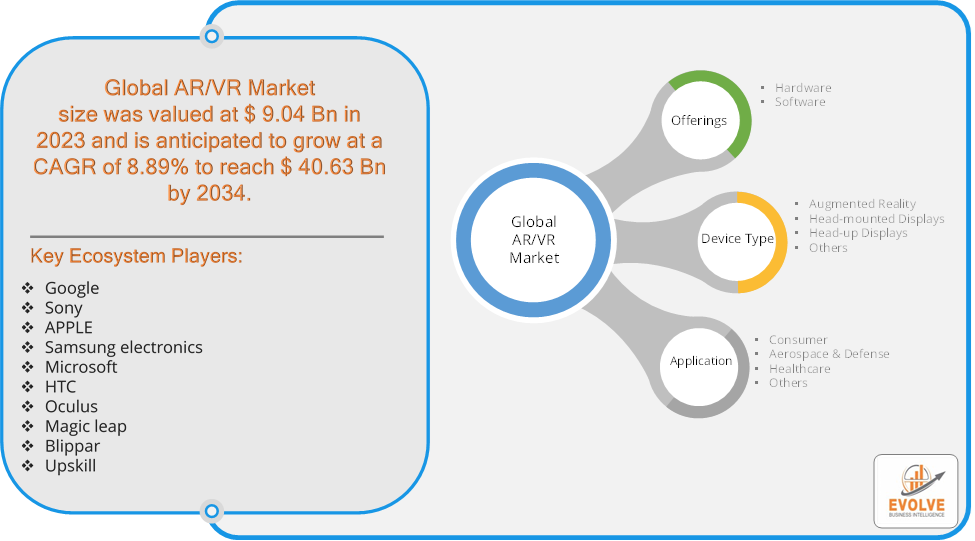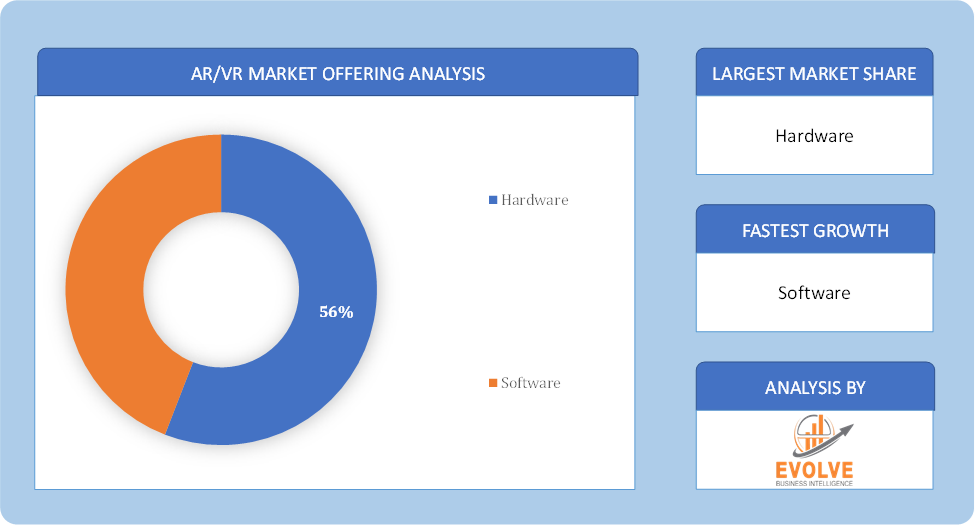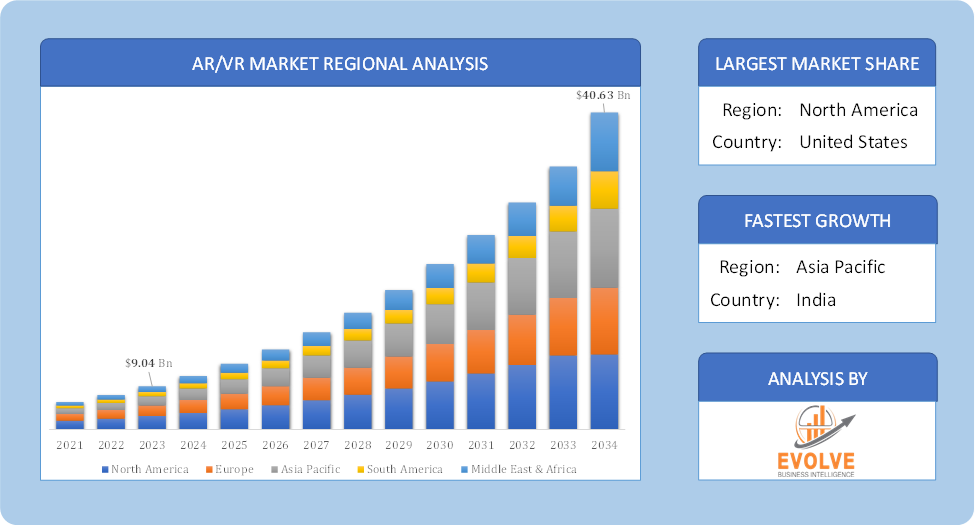AR VR Market Analysis and Global Forecast 2021-2034
$ 1,390.00 – $ 5,520.00Price range: $ 1,390.00 through $ 5,520.00
AR VR Market Research Report: By Offering (Hardware, Software), By Device Type (Augmented Reality, Head-mounted Displays, Head-up Displays, Others), By Application (Consumer, Aerospace & Defense, Healthcare, Others), and by Region — Forecast till 2034
Page: 169
AR VR Market Overview
The AR VR Market size accounted for USD 9.04 Billion in 2023 and is estimated to account for 10.21 Billion in 2024. The Market is expected to reach USD 40.63 Billion by 2034 growing at a compound annual growth rate (CAGR) of 8.89% from 2024 to 2034. The immersive technologies that combine digital material with the real or virtual world are the main focus of the AR/VR (Augmented Reality/Virtual Reality) business. While VR develops entirely simulated settings for consumers to experience, AR overlays digital elements in a real-world environment to enhance user interaction. The industry is primarily driven by improvements in hardware, 5G, and the growing number of use cases in industries including gaming, healthcare, education, and retail. Due to the growth of remote work, virtual collaboration, and entertainment needs, both AR and VR are becoming more and more popular. High expenses, privacy issues, and obstacles to content development are major issues.
Global AR VR Market Synopsis
 Global AR VR Market Dynamics
Global AR VR Market Dynamics
The major factors that have impacted the growth of AR/VR are as follows:
Drivers:
⮚ Technological Advancements
The continuous improvement in AR/VR technology, including higher resolution displays, better motion tracking, and improved sensors, has greatly enhanced the user experience. Advancements in AI and machine learning are also enabling more immersive and interactive experiences, driving adoption in various sectors. For instance, the development of lightweight, wireless headsets with better battery life is making AR/VR devices more user-friendly and accessible.
Restraint:
- Privacy and Security Concerns
AR/VR technologies rely on the collection of large amounts of data, including personal data, location tracking, and real-time monitoring of movements and behaviors. This creates potential privacy and security concerns, as sensitive data could be exposed to hackers or third parties. The lack of standardized regulations and frameworks for AR/VR data security exacerbates these concerns, particularly in applications where AR/VR is used for sensitive tasks such as healthcare or military training. Without clear and enforced regulations, businesses and consumers alike are hesitant to adopt AR/VR technologies on a large scale.
Opportunity:
⮚ Remote Collaboration and Virtual Meetings
The shift to remote work has heightened the demand for effective collaboration tools. AR and VR can facilitate immersive virtual meetings and team collaborations, allowing teams to interact as if they were in the same room. For instance, architects and designers can walk through a virtual model of a building, making real-time adjustments while collaborating with clients or stakeholders. As businesses seek to maintain productivity in hybrid work environments, AR/VR solutions for remote collaboration will gain traction.
AR/VR Market Segment Overview
Based on the Offerings, the market is segmented based on Hardware, Software. the Hardware segment currently dominates, driven by the demand for advanced headsets, sensors, and other physical devices essential for immersive experiences. However, the Software segment is rapidly growing, fueled by increasing content creation and application development across various industries.
By Device Type
Based on the Device Type, the market has been divided into Augmented Reality, Head-mounted Displays, Head-up Displays, Others. Head-mounted Displays (HMDs) dominate the segment based on device type, largely due to their widespread use in gaming, training, and immersive experiences. Augmented Reality devices also show strong growth, particularly in mobile applications and industrial use cases.
By Application
Based on Application, the market has been divided into Consumer, Aerospace & Defense, Healthcare, Others. the Healthcare segment currently dominates due to its extensive applications in training, surgical simulations, and patient treatment, driven by the demand for innovative solutions in medical education and therapy. Following closely are Consumer applications, particularly in gaming and retail, which also exhibit significant growth potential.
Global AR/VR Market Regional Analysis
Based on region, the market has been divided into North America, Europe, Asia-Pacific, the Middle East & Africa, and Latin America. The area of North America is anticipated to dominate the market for the usage of AR/VR, followed by those in Asia-Pacific and Europe.
 AR VR North America Market
AR VR North America Market
North America dominates the AR/VR market due to several factors. Throughout the projected period, North America is anticipated to develop at the quickest rate among regional markets. This is because virtual reality technology is being widely used in a variety of applications across a wide range of industry sectors, especially the gaming and automotive industries. The greater number of gamers in Europe helps explain why cutting-edge VR headsets are more popular there. The expansion of the regional market has been accelerated by the rapid development and distribution of powerful VR hardware sets aimed at the gaming community.
AR VR Asia Pacific Market
The Asia-Pacific region has been witnessing remarkable growth in recent years. Due to continuous improvements in VR technology, Asia-Pacific reported the greatest revenue share in the AR/VR market in 2021. Due to China’s prominence as a distributor of HMDs and other VR-related gear, the country’s VR sector has experienced tremendous growth. Southeast Asian countries’ markets are expanding thanks in part to technological advancements. Telecom providers have been using strategic creativity to offer augmented reality and virtual reality watching platforms that utilize 5G connectivity since Japan began commercial 5G services in 2019.
Competitive Landscape
The competitive landscape includes key players (tier 1, tier 2, and local) having a presence across the globe. Companies such as Google, Sony, APPLE, Samsung electronics, and Microsoft are some of the leading players in the global AR/VR Industry. These players have adopted partnership, acquisition, expansion, and new product development, among others as their key strategies.
Key Market Players:
- Sony
- APPLE
- Samsung electronics
- Microsoft
- HTC
- Oculus
- Magic leap
- Blippar
Key development:
In September 2023, Google announced advancements in its AR technology, focusing on enhancing user experiences with more interactive and contextual overlays in its apps, alongside partnerships aimed at integrating AR features into various industries, such as retail and education.
Scope of the Report
Global AR/VR Market, by Offerings
- Hardware
- Software
Global AR/VR Market, by Device Type
- Augmented Reality
- Head-mounted Displays
- Head-up Displays
- Others
Global AR/VR Market, by Application
- Consumer
- Aerospace & Defense
- Healthcare
- Others
Global AR/VR Market, by Region
- North America
- US
- Canada
- Mexico
- Europe
- UK
- Germany
- France
- Italy
- Spain
- Benelux
- Nordic
- Rest of Europe
- Asia Pacific
- China
- Japan
- South Korea
- Indonesia
- Austalia
- Malaysia
- India
- Rest of Asia Pacific
- South America
- Brazil
- Argentina
- Rest of South America
- Middle East & Africa
- Saudi Arabia
- UAE
- Egypt
- South Africa
- Rest of Middle East & Africa
| Parameters | Indicators |
|---|---|
| Market Size | 2034: USD 40.63 Billion |
| CAGR (2021-2034) | 8.89% |
| Base year | 2023 |
| Forecast Period | 2021-2034 |
| Historical Data | 2021 (2017 to 2020 On Demand) |
| Report Coverage | Revenue Forecast, Competitive Landscape, Growth Factors, and Trends |
| Key Segmentations | Offerings, Device Type, Application |
| Geographies Covered | North America, Europe, Asia-Pacific, South America, Middle East, Africa. |
| Key Vendors | Google, Sony, APPLE, Samsung electronics, Microsoft, HTC, Oculus, Magic leap, Blippar, Upskill. |
| Key Market Opportunities | · The industrial automation industry is expected to boost the augmented and virtual reality markets. |
| Key Market Drivers | · The surge in the adoption of augmented reality and virtual reality in the infotainment industry |
REPORT CONTENT BRIEF:
- High-level analysis of the current and future AR/VR market trends and opportunities
- Detailed analysis of current market drivers, restraining factors, and opportunities in the future
- AR/VR market historical market size for the year 2022, and forecast from 2021 to 2034
- AR/VR market share analysis at each product level
- Competitor analysis with detailed insight into its product segment, Government & Defense strength, and strategies adopted.
- Identifies key strategies adopted including product launches and developments, mergers and acquisitions, joint ventures, collaborations, and partnerships as well as funding taken and investment done, among others.
- To identify and understand the various factors involved in the global AR/VR market affected by the pandemic
- To provide a detailed insight into the major companies operating in the market. The profiling will include the Government & Defense health of the company’s past 2-3 years with segmental and regional revenue breakup, product offering, recent developments, SWOT analysis, and key strategies.
Frequently Asked Questions (FAQ)
What is the study period of this market?
The study period of the global AR/VR market is 2021- 2034
What are the 10 Years CAGR (2021 to 2034) of the global AR/VR market?
The global AR/VR market is growing at a CAGR of ~8.89% over the next 10 years
Which region has the highest growth rate in the market of AR/VR?
Asia Pacific is expected to register the highest CAGR during 2021-2034
Which region accounted for the largest share of the market of AR/VR?
North America holds the largest share in 2023
Major Key Players in the Market of AR/VR?
Google, Sony, APPLE, Samsung electronics, Microsoft, HTC, Oculus, Magic leap, Blippar, Upskill.
Do you offer Post Sale Support?
Yes, we offer 16 hours of analyst support to solve the queries
Do you deliver sections of a report?
Yes, we do provide regional as well as country-level reports. Other than this we also provide a sectional report. Please get in contact with our sales representatives.
Press Release

Global Pharmaceutical Manufacturing Market to Reach $1.38 Trillion by 2035 with 7.35% CAGR, New Research Shows

The Global Mammography Market Is Estimated To Record a CAGR of Around 10.29% During The Forecast Period

Glue Stick Market to Reach USD 2.35 Billion by 2034

Podiatry Service Market to Reach USD 11.88 Billion by 2034

Microfluidics Technology Market to Reach USD 32.58 Billion by 2034

Ferric Chloride Market to Reach USD 10.65 Billion by 2034

Family Practice EMR Software Market to Reach USD 21.52 Billion by 2034

Electric Hairbrush Market to Reach USD 15.95 Billion by 2034

Daily Bamboo Products Market to Reach USD 143.52 Billion by 2034

Cross-border E-commerce Logistics Market to Reach USD 112.65 Billion by 2034
Table of Content
CHAPTER 1. Executive Summary CHAPTER 2. Scope of the Study 2.1. Market Definition 2.2. Market Scope & Segmentation 2.2.1. Objective of Report CHAPTER 3. Evolve BI Methodology 3.1. Data Collection & Validation Approach 3.2. Market Size Estimation and Forecast CHAPTER 4. Exclusive Analysis 4.1. Market Opportunity Score 4.1.1. Offerings Segement – Market Opportunity Score 4.1.2. Device Type Segment – Market Opportunity Score 4.1.3. Application Segment – Market Opportunity Score 4.2. Key Market Influencing Indicators CHAPTER 5. Market Insights and Trends 5.1. Value Chain Analysis 5.1.1. Raw Material 5.1.2. Manufacturing Process 5.1.3. Distribution Channel 5.1.4. End User 5.2. Porter’s Five Forces Analysis 5.2.1. Bargaining Power of Buyers 5.2.2. Bargaining Power of Suppliers 5.2.3. Threat of New Entrant 5.2.4. Threat of Substitute 5.2.5. Industry Rivalry 5.3. COVID-19 Impact and Post COVID Scenario on AR/VR Market 5.3.1. Impact of COVID-19 5.3.2. Government Support and Industry Revival Policies 5.3.3. Measures Taken by Companies to Mitigate Negative Impact 5.3.4. Post COVID Trend CHAPTER 6. MArket Dynamics 6.1. Introduction 6.2. Drivers 6.2.1. Driver 1 6.2.2. Driver 2 6.2.3. Driver 3 6.3. Restraints 6.3.1. Restraint 1 6.3.2. Restraint 2 6.4. Opportunity 6.4.1. Opportunity 1 CHAPTER 7. Global AR/VR Market, By Offerings 7.1. Introduction 7.1.1. Hardware 7.1.2. Software CHAPTER 8. Global AR/VR Market, By Device Type 8.1. Introduction 8.1.1. Augmented Reality 8.1.2. Head-mounted Displays 8.1.3. Head-up Displays 8.1.4. Others CHAPTER 9. Global AR/VR Market, By Application 9.1. Introduction 9.1.1. Consumer 9.1.2. Aerospace & Defense 9.1.3. Healthcare 9.1.4. Others CHAPTER 10. Global AR/VR Market, By Region 10.1. Introduction 10.2. NORTH AMERICA 10.2.1. North America: Market Size and Forecast, By Country, 2021 – 2034 ($ Million) 10.2.2. North America: Market Size and Forecast, By Offerings, 2021 – 2034 ($ Million) 10.2.3. North America: Market Size and Forecast, By Device Type, 2021 – 2034 ($ Million) 10.2.4. North America: Market Size and Forecast, By Application, 2021 – 2034 ($ Million) 10.2.5. US 10.2.5.1. US: Market Size and Forecast, By Offerings, 2021 – 2034 ($ Million) 10.2.5.2. US: Market Size and Forecast, By Device Type, 2021 – 2034 ($ Million) 10.2.5.3. US: Market Size and Forecast, By Application, 2021 – 2034 ($ Million) 10.2.6. CANADA 10.2.6.1. Canada: Market Size and Forecast, By Offerings, 2021 – 2034 ($ Million) 10.2.6.2. Canada: Market Size and Forecast, By Device Type, 2021 – 2034 ($ Million) 10.2.6.3. Canada: Market Size and Forecast, By Application, 2021 – 2034 ($ Million) 10.2.7. MEXICO 10.2.7.1. Mexico: Market Size and Forecast, By Offerings, 2021 – 2034 ($ Million) 10.2.7.2. Mexico: Market Size and Forecast, By Device Type, 2021 – 2034 ($ Million) 10.2.7.3. Mexico: Market Size and Forecast, By Application, 2021 – 2034 ($ Million) 10.3. Europe 10.3.1. Europe: Market Size and Forecast, By Country, 2021 – 2034 ($ Million) 10.3.2. Europe: Market Size and Forecast, By Offerings, 2021 – 2034 ($ Million) 10.3.3. Europe: Market Size and Forecast, By Device Type, 2021 – 2034 ($ Million) 10.3.4. Europe: Market Size and Forecast, By Application, 2021 – 2034 ($ Million) 10.3.5. U.K. 10.3.5.1. U.K.: Market Size and Forecast, By Offerings, 2021 – 2034 ($ Million) 10.3.5.2. U.K.: Market Size and Forecast, By Device Type, 2021 – 2034 ($ Million) 10.3.5.3. U.K.: Market Size and Forecast, By Application, 2021 – 2034 ($ Million) 10.3.6. GERMANY 10.3.6.1. Germany: Market Size and Forecast, By Offerings, 2021 – 2034 ($ Million) 10.3.6.2. Germany: Market Size and Forecast, By Device Type, 2021 – 2034 ($ Million) 10.3.6.3. Germany: Market Size and Forecast, By Application, 2021 – 2034 ($ Million) 10.3.7. FRANCE 10.3.7.1. France: Market Size and Forecast, By Offerings, 2021 – 2034 ($ Million) 10.3.7.2. France: Market Size and Forecast, By Device Type, 2021 – 2034 ($ Million) 10.3.7.3. France: Market Size and Forecast, By Application, 2021 – 2034 ($ Million) 10.3.8. ITALY 10.3.8.1. Italy: Market Size and Forecast, By Offerings, 2021 – 2034 ($ Million) 10.3.8.2. Italy: Market Size and Forecast, By Device Type, 2021 – 2034 ($ Million) 10.3.8.3. Italy: Market Size and Forecast, By Application, 2021 – 2034 ($ Million) 10.3.9. SPAIN 10.3.9.1. Spain: Market Size and Forecast, By Offerings, 2021 – 2034 ($ Million) 10.3.9.2. Spain: Market Size and Forecast, By Device Type, 2021 – 2034 ($ Million) 10.3.9.3. Spain: Market Size and Forecast, By Application, 2021 – 2034 ($ Million) 10.3.10. BENELUX 10.3.10.1. BeNeLux: Market Size and Forecast, By Offerings, 2021 – 2034 ($ Million) 10.3.10.2. BeNeLux: Market Size and Forecast, By Device Type, 2021 – 2034 ($ Million) 10.3.10.3. BeNeLux: Market Size and Forecast, By Application, 2021 – 2034 ($ Million) 10.3.11. RUSSIA 10.3.11.1. Russia: Market Size and Forecast, By Offerings, 2021 – 2034 ($ Million) 10.3.11.2. Russia: Market Size and Forecast, By Device Type, 2021 – 2034 ($ Million) 10.3.11.3. Russia: Market Size and Forecast, By Application, 2021 – 2034 ($ Million) 10.3.12. REST OF EUROPE 10.3.12.1. Rest of Europe: Market Size and Forecast, By Offerings, 2021 – 2034 ($ Million) 10.3.12.2. Rest of Europe: Market Size and Forecast, By Device Type, 2021 – 2034 ($ Million) 10.3.12.3. Rest of Europe: Market Size and Forecast, By Application, 2021 – 2034 ($ Million) 10.4. Asia Pacific 10.4.1. Asia Pacific: Market Size and Forecast, By Country, 2021 – 2034 ($ Million) 10.4.2. Asia Pacific: Market Size and Forecast, By Offerings, 2021 – 2034 ($ Million) 10.4.3. Asia Pacific: Market Size and Forecast, By Device Type, 2021 – 2034 ($ Million) 10.4.4. Asia Pacific: Market Size and Forecast, By Application, 2021 – 2034 ($ Million) 10.4.5. CHINA 10.4.5.1. China: Market Size and Forecast, By Offerings, 2021 – 2034 ($ Million) 10.4.5.2. China: Market Size and Forecast, By Device Type, 2021 – 2034 ($ Million) 10.4.5.3. China: Market Size and Forecast, By Application, 2021 – 2034 ($ Million) 10.4.6. JAPAN 10.4.6.1. Japan: Market Size and Forecast, By Offerings, 2021 – 2034 ($ Million) 10.4.6.2. Japan: Market Size and Forecast, By Device Type, 2021 – 2034 ($ Million) 10.4.6.3. Japan: Market Size and Forecast, By Application, 2021 – 2034 ($ Million) 10.4.7. INDIA 10.4.7.1. India: Market Size and Forecast, By Offerings, 2021 – 2034 ($ Million) 10.4.7.2. India: Market Size and Forecast, By Device Type, 2021 – 2034 ($ Million) 10.4.7.3. India: Market Size and Forecast, By Application, 2021 – 2034 ($ Million) 10.4.8. SOUTH KOREA 10.4.8.1. South Korea: Market Size and Forecast, By Offerings, 2021 – 2034 ($ Million) 10.4.8.2. South Korea: Market Size and Forecast, By Device Type, 2021 – 2034 ($ Million) 10.4.8.3. South Korea: Market Size and Forecast, By Application, 2021 – 2034 ($ Million) 10.4.9. THAILAND 10.4.9.1. Thailand: Market Size and Forecast, By Offerings, 2021 – 2034 ($ Million) 10.4.9.2. Thailand: Market Size and Forecast, By Device Type, 2021 – 2034 ($ Million) 10.4.9.3. Thailand: Market Size and Forecast, By Application, 2021 – 2034 ($ Million) 10.4.10. INDONESIA 10.4.10.1. Indonesia: Market Size and Forecast, By Offerings, 2021 – 2034 ($ Million) 10.4.10.2. Indonesia: Market Size and Forecast, By Device Type, 2021 – 2034 ($ Million) 10.4.10.3. Indonesia: Market Size and Forecast, By Application, 2021 – 2034 ($ Million) 10.4.11. MALAYSIA 10.4.11.1. Malaysia: Market Size and Forecast, By Offerings, 2021 – 2034 ($ Million) 10.4.11.2. Malaysia: Market Size and Forecast, By Device Type, 2021 – 2034 ($ Million) 10.4.11.3. Malaysia: Market Size and Forecast, By Application, 2021 – 2034 ($ Million) 10.4.12. AUSTRALIA 10.4.12.1. Australia: Market Size and Forecast, By Offerings, 2021 – 2034 ($ Million) 10.4.12.2. Australia: Market Size and Forecast, By Device Type, 2021 – 2034 ($ Million) 10.4.12.3. Australia: Market Size and Forecast, By Application, 2021 – 2034 ($ Million) 10.4.13. REST FO ASIA PACIFIC 10.4.13.1. Rest fo Asia Pacific: Market Size and Forecast, By Offerings, 2021 – 2034 ($ Million) 10.4.13.2. Rest fo Asia Pacific: Market Size and Forecast, By Device Type, 2021 – 2034 ($ Million) 10.4.13.3. Rest fo Asia Pacific: Market Size and Forecast, By Application, 2021 – 2034 ($ Million) 10.5. South America 10.5.1. South America: Market Size and Forecast, By Country, 2021 – 2034 ($ Million) 10.5.2. South America: Market Size and Forecast, By Offerings, 2021 – 2034 ($ Million) 10.5.3. South America: Market Size and Forecast, By Device Type, 2021 – 2034 ($ Million) 10.5.4. South America: Market Size and Forecast, By Application, 2021 – 2034 ($ Million) 10.5.5. BRAZIL 10.5.5.1. Brazil: Market Size and Forecast, By Offerings, 2021 – 2034 ($ Million) 10.5.5.2. Brazil: Market Size and Forecast, By Device Type, 2021 – 2034 ($ Million) 10.5.5.3. Brazil: Market Size and Forecast, By Application, 2021 – 2034 ($ Million) 10.5.6. ARGENTINA 10.5.6.1. Argentina: Market Size and Forecast, By Offerings, 2021 – 2034 ($ Million) 10.5.6.2. Argentina: Market Size and Forecast, By Device Type, 2021 – 2034 ($ Million) 10.5.6.3. Argentina: Market Size and Forecast, By Application, 2021 – 2034 ($ Million) 10.5.7. REST OF SOUTH AMERICA 10.5.7.1. Rest of South America: Market Size and Forecast, By Offerings, 2021 – 2034 ($ Million) 10.5.7.2. Rest of South America: Market Size and Forecast, By Device Type, 2021 – 2034 ($ Million) 10.5.7.3. Rest of South America: Market Size and Forecast, By Application, 2021 – 2034 ($ Million) 10.6. Middle East & Africa 10.6.1. Middle East & Africa: Market Size and Forecast, By Country, 2021 – 2034 ($ Million) 10.6.2. Middle East & Africa: Market Size and Forecast, By Offerings, 2021 – 2034 ($ Million) 10.6.3. Middle East & Africa: Market Size and Forecast, By Device Type, 2021 – 2034 ($ Million) 10.6.4. Middle East & Africa: Market Size and Forecast, By Application, 2021 – 2034 ($ Million) 10.6.5. SAUDI ARABIA 10.6.5.1. Saudi Arabia: Market Size and Forecast, By Offerings, 2021 – 2034 ($ Million) 10.6.5.2. Saudi Arabia: Market Size and Forecast, By Device Type, 2021 – 2034 ($ Million) 10.6.5.3. Saudi Arabia: Market Size and Forecast, By Application, 2021 – 2034 ($ Million) 10.6.6. UAE 10.6.6.1. UAE: Market Size and Forecast, By Offerings, 2021 – 2034 ($ Million) 10.6.6.2. UAE: Market Size and Forecast, By Device Type, 2021 – 2034 ($ Million) 10.6.6.3. UAE: Market Size and Forecast, By Application, 2021 – 2034 ($ Million) 10.6.7. EGYPT 10.6.7.1. Egypt: Market Size and Forecast, By Offerings, 2021 – 2034 ($ Million) 10.6.7.2. Egypt: Market Size and Forecast, By Device Type, 2021 – 2034 ($ Million) 10.6.7.3. Egypt: Market Size and Forecast, By Application, 2021 – 2034 ($ Million) 10.6.8. SOUTH AFRICA 10.6.8.1. South Africa: Market Size and Forecast, By Offerings, 2021 – 2034 ($ Million) 10.6.8.2. South Africa: Market Size and Forecast, By Device Type, 2021 – 2034 ($ Million) 10.6.8.3. South Africa: Market Size and Forecast, By Application, 2021 – 2034 ($ Million) 10.6.9. REST OF MIDDLE EAST & AFRICA 10.6.9.1. Rest of Middle East & Africa: Market Size and Forecast, By Offerings, 2021 – 2034 ($ Million) 10.6.9.2. Rest of Middle East & Africa: Market Size and Forecast, By Device Type, 2021 – 2034 ($ Million) 10.6.9.3. Rest of Middle East & Africa: Market Size and Forecast, By Application, 2021 – 2034 ($ Million) CHAPTER 12. Competitive Landscape 12.1. Competitior Benchmarking 2021 12.2. Market Share Analysis 12.3. Key Developments Analysis By Top 5 Companies 12.4. Market Share Acquisition Strategies: Analysis of Key Approaches Employed by Top Players CHAPTER 13. Company Profiles 13.1. Google 13.1.1. Business Overview 13.1.2. Financial Analysis 13.1.2.1. Business Segment Revenue, 2020, 2021, 2022, $ Million 13.1.2.2. Geographic Revenue Mix, 2022 (% Share) 13.1.3. Product Portfolio 13.1.4. Recent Development and Strategies Adopted 13.1.5. SWOT Analysis 13.2. Sony 13.3. APPLE 13.4. Samsung electronics 13.5. Microsoft 13.6. HTC 13.7. Oculus 13.8. Magic leap 13.9. Blippar 13.10. Upskill
Connect to Analyst
Research Methodology









